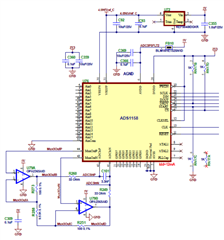Other Parts Discussed in Thread: OPA2365
Hi,
We've been using Scan-Mode and the lowest Data-Rate, but the values are not as close as we would expect. We would like to experiment with Fixed-Channel-Mode.
Based on the datasheet, the config register is set for Fixed-Mode , external ADCInP/N, and Chop-Enable, (i.e. Reg 0x00 changed from 0x1E to 0x3E )
However, since all 16 channels are single-ended, and the external conditioner is present, what value does MUXSCH's AINNX expect since all AIN inputs are in reference to AInCom/MuxOutN/AdcInN.
Also, are there any other changes to the register-configuration and/or the circuit, that could improve accuracy? For example, given an input voltage of 1.35v at the ADC, the ADS1158 reports 0x2871-0x2874, which would equate to about 1.38 (0x2873 * 4.096v/30720).



